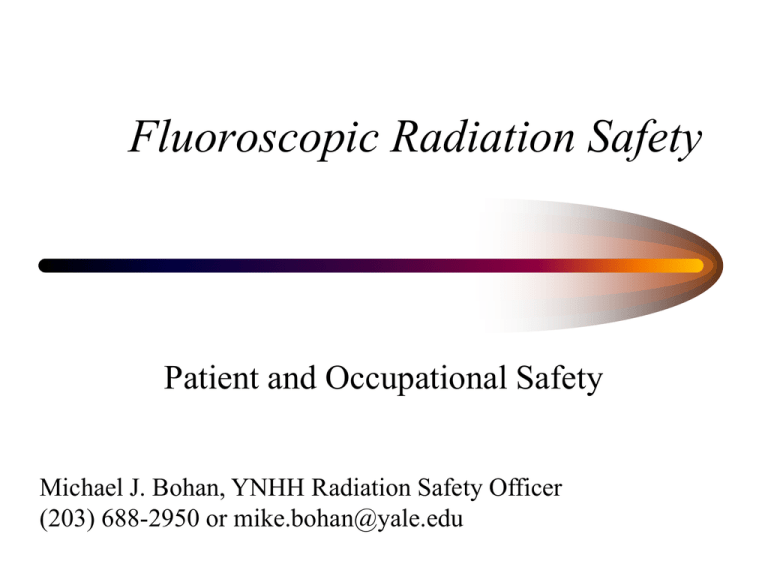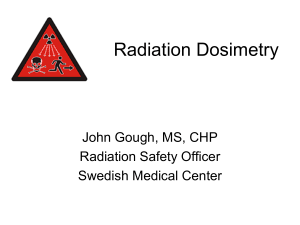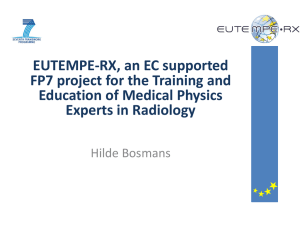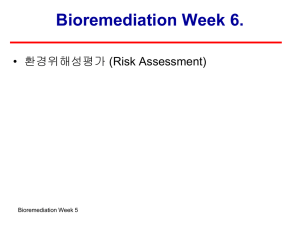Radiation Safety
advertisement

Fluoroscopic Radiation Safety Patient and Occupational Safety Michael J. Bohan, YNHH Radiation Safety Officer (203) 688-2950 or mike.bohan@yale.edu ACCREDITATION & DISCLOSURE The Yale School of Medicine designates this Enduring Material for a maximum of 1 AMA PRA Category 1 Credit™. Physicians should claim only the credit commensurate with the extent of their participation in the activity. Acknowledgement is made on behalf of the Department that: There is no commercial support for this activity. Confirmation is also made that disclosure has been peer reviewed and there are no conflicts of interest. Basic Radiation Safety Techniques Time - As exposure time increases, dose accumulates -- Keep fluoro times as short as possible. A bell or buzzer will go off after 5 minutes of beam time, keep track of fluoro time, report fluoro times in excess of 60 minutes to the Radiation Safety Office (203) 688-2950 Distance - As distance from the radiation source increases, the radiation intensity decreases rapidly by the inverse square law. -- Keep patient anatomy and staff as far away from the x-ray tube port as possible Shielding - Diagnostic x-rays are easily shielded with thin sheets of lead. -- Wear lead aprons, thyroid shields, leaded glasses and use overhead leaded shields and table skirts whenever possible Keep fluoro times as short as possible Dose Rate = 10 rad/min Accumulated Dose (rad) minutes Time Stay as far away from the x-ray tube port as possible Distance 1/(0.5 ft)2 = 4 times dose rate @ 1 foot! Inverse Square Law 1/(1)2 = 1 Percent of exposure rate at 1 foot 1/(2)2 = 1/4 1/(3)2 = 1/9, etc. Feet from radiation source Lead aprons are very effective at diagnostic x-ray energies and shield at least 95% of the radiation Percent Transmission Half-value Layer -ln(2)t/HVL I = Io e Half-value Layers Federal Regulatory Occupational Dose Limits Total Effective Dose Limit (TEDE) 5,000 millirem/yr Individual Organ Limit 50,000 millirem/yr Len of the Eye (LDE) 15,000 millirem/yr Skin, Hands & Single Organs 50,000 millirem/yr TEDE - Summation of external and weighted internal doses Federal Regulatory Internal Dose Weighting Factors The organ weighting factors take into consideration the radiation sensitivity of the tissues. Organ or tissue Gonads Breast Red bone marrow Lung Thyroid Bone surfaces Remaining organs Total body Weighting Factor 0.25 0.15 0.12 0.12 0.03 0.03 0.30 1.00 Federal Regulatory General Public Dose Limits Total dose (all sources) 500 millirem/yr Individual source limit 100 millirem/yr Declared pregnant worker 500 mrem/9 months (<50 mrem/month) Occupational Exposures at Yale-New Haven Hospital Occupational Exposures at Yale-New Haven Hospital Ninety-seven percent of all monitored individuals at YNHH receive less than 10% of the annual exposure limit (500 mrem/yr). The 3% who receive greater than 500 millirem/yr are the interventional radiologists and cardiologists. Personnel who routinely receive greater than 10% of the limits are issued two film badges (collar & waist) If you are issued only one badge, wear it at the collar outside of any protective aprons. Waist badges should be worn under protective aprons Multiple Badge Fluoroscopic Dosimetry Effective dose equivalent is calculated for multiple badge wearers using the ANSI formula as required by CT State DEP regulatory guidance. Effective Dose Equivalent = (0.11 x collar badge) + (0.89 x waist badge) HPS N13.41-1997 An American National Standard (ANSI) Criteria for Performing Multiple Dosimetry Multiple Badge Fluoroscopic Dosimetry For example, if a fluoroscopist received 2,500 millirem to their collar badge and 250 millirem to their waist badge for the year, their effective dose equivalent (EDE) would be: (0.11 * 2,500 mrem/yr) + (0.89 * 250 mrem/yr) = ANSI EDE 275 mrem/yr + 223 mrem/yr = 498 mrem/yr Patient Safety Issues • Fluoroscopic techniques are being used by an increasing number of clinicians not adequately trained in radiation safety or radiobiology • Patients are suffering radiation-induced skin injuries due to unnecessarily high radiation doses. Younger patients may face an increased risk of future cancer. • Many fluoroscopic users are not aware of the potential for injury from procedures, their occurrence or the simple methods for decreasing their incidence utilizing dose control strategies. Patient Safety Issues • Many patients are not being adequately counseled about radiation risks before consent for difficult and challenging procedures, nor followed up for the onset of injury, when radiological procedures result in high doses. • Untrained and inexperienced fluoroscopists have injured patients and exposed staff to high doses. • Occupational doses can be reduced by limiting unnecessary patient dose, through the correct use and procurement of equipment (including the use of shielding devices). The X-ray Imaging Process Primary x-ray beam Absorption and transmission of x-rays contribute to the imaging process and patient dose. Scattered or partially absorbed x– rays contribute to occupational exposure, but are less than 1% of the primary beam intensity. Image Receptor Absorption Scatter x-rays Transmission T ube Focal Spot X-Ray Beam Spectrum - 100 kVp • • • • • • • A. - Hypothetical x-ray spectrum B. - Spectrum from tungsten target without filtration C. - Spectrum with filtration equivalent to 2.4 mm Al (inherent + added) The mean x-ray energy (keV) is approximately 1/3 the peak energy (kVp) Unfiltered x-ray beams cause excessive dose to skin because low energy photons cannot penetrate through the patient keV - kilovolt kVp - kiloVolt peak These x-rays only cause dose to the patient and do not contribute to the imaging process The X-ray Imaging Process Collimation of the x-ray beam reduces dose to the patient, to the staff and improves image quality due to reduction in x-ray scatter. Always collimate down once you get to the area of interest. The X-ray Imaging Process Primary x-ray beam Dose Rates 0.02 rad/min Good Image Receptor The Good, The Bad, and the Ugly Primary x-ray beam Dose Rates 0.02 rad/min Image Receptor Bad and Ugly Bad Geometry Higher Dose Rate 2 rad/min Good Geometry Lower Dose Rat e 8 rad/min 32 rad/min 128 rad/min T ube Focal Spot Entrance Dose Rates Bett er Image Q uality 2 rad/min More Im age Magnificat ion 8 rad/min Less Image M agnificat ion Good Geometry 2 rad/min Bad Geometry 32 rad/min! P oorer Image Qualit y 32 rad/min 128 rad/min T ube Focal Spot The X-ray Imaging Process Primary x-ray beam Image Receptor Dose Rates 2 rad/min T ube Focal Spot Fluoroscopes are routinely operated in automatic exposure mode. Average Adult Primary x-ray beam Image Receptor Dose Rates 5 rad/min As the patient becomes thicker x-ray output goes higher to maintain image quality T ube Focal Spot Obese Adult A Typical Fluoroscopic Lab Overhead shields need to be positioned down next to the patient and adjacent to the image intensifier to seal scatter off from below. Table skirts shield the highest backscatter levels from the x-ray tube. Case Reports • Patient skin doses in some interventional procedures approach those experienced in some cancer radiotherapy fractions • Skin injuries are occurring in patients as a result of very high radiation doses during interventional procedures, as a result of the use of inappropriate equipment and more often poor operational technique. • Injuries to physicians and staff performing interventional procedures have been observed recently, due to the use of inappropriate equipment, poor operational technique and less than optimal radiation safety practices. Doses in interventional procedures Effect Threshold dose (rad) Minutes fluoro Minutes fluoro at 2 rad/min at 20 rad/min Transient erythema 200 100 10 Permanent epilation 700 350 35 Dry desquamation 1,400 700 70 Dermal necrosis 1,800 900 90 Telangiectasia 1,000 500 50 Cataract >500 >250 to eye >25 to eye Not known Not known Not known Skin cancer • FIG.1 – Radiation wound 22 months after angioplasty procedure. – Injury resulted in dermal necrosis – Dose > 1,800 rad – > 360 minutes fluoro time During long procedures, move beam entry point to spread cumulative dose Typical fluoro skin entrance dose rate ≈ 2 - 5 rad/min Case Study Case Study • FIG.2 – Patient arm exposed to lateral c-arm radiation. – Elbow was located right next to x-ray tube port 1. Keep arm out of lateral fields 2. Keep x-ray tube port as far from the skin as possible 3. Patient should be closest to the image intensifier Controlling Patient Dose • Practical Actions: To control dose to the patient & staff – Keep beam-on time to an absolute minimum --The Golden Rule – Reduce fluoroscopy pulses/sec to as low as possible/suitable (30/sec, 15/sec, 7/sec, 3/sec) – Reduce cine frame rates (4, 2 or 1/sec) – Remember that dose rates will be greater and dose will accumulate faster in larger patients. Controlling Patient Dose – Keep the tube current as low as possible by keeping the kVp as high as possible to achieve the appropriate compromise between image quality and low patient dose. – Keep the x-ray tube at maximal distance from the patient. Controlling Patient Dose – Keep the image intensifier as close to the patient as possible. – Don’t “over use” geometric magnification. • Smaller I.I. view increases dose rate – Consider removing the grid during procedures on small patients (pediatric cases) or when the image intensifier cannot be placed close to the patient. Controlling Patient Dose – Always collimate closely to the area of interest. – Use the last image hold feature whenever possible, don’t use live fluoro to confirm static information – When the procedure is unexpectedly prolonged, consider options for positioning the patient or altering the field so that the same area of skin is not continuously in the direct x-ray field. Controlling Staff Dose • To control dose to the staff: – Personnel must wear protective aprons, use shielding, monitor their doses, and know how to position themselves and the machines for minimum dose. • Overhead glass & table apron shields – If the beam is horizontal, or near horizontal, the operator should stand on the image intensifier side [to reduce dose]. Plan view of an interventional operating x-ray unit with isodose curves Dose rates are 4 times higher on the x-ray tube side Controlling Staff Dose – If the beam is vertical, or near vertical, keep the tube under the patient. Use table “skirt” shields whenever available. – The one exception to this rule is for mini C-arms. When used for extremities, the dose rates are low enough that for practical reasons it is better to have the x-ray tube above the stage. – Wear your film badge monitors properly and return them promptly. • Collar Badges - Outside protective aprons • Waist Badges - Under protective aprons Mini C-arms – Mini C-arms emit about 1/10th the dose rate as compared to a regular – C-arm. – However, good radiation safety practices must still be followed to keep staff and patient exposure As Low as Reasonably Achievable (ALARA). – Leaded aprons should be worn by all personnel located within 6 feet – (2 meters) of the Mini C-arm during operation. – Mini C-arms should be limited to extremity use only. They are not designed to examine thick structures. – Since Mini C-arms are commonly used for pediatric purposes, limiting exposure time is still important in minimizing long term radiation risk to this population. Additional Resources and References For additional training contact the YNHH Radiation Safety Office at (203) 688-2950 or mike.bohan@yale.edu Online References: http://www.e-radiography.net/radsafety/rad_physics.htm http://www.fda.gov/RadiationEmittingProducts/RadiationEmittingProductsandProcedures/MedicalIm aging/MedicalX-Rays/ucm116672.htm http://www.icrp.org/downloadDoc.asp?document=docs/ICRP_85_Inter ventional_s.pps









